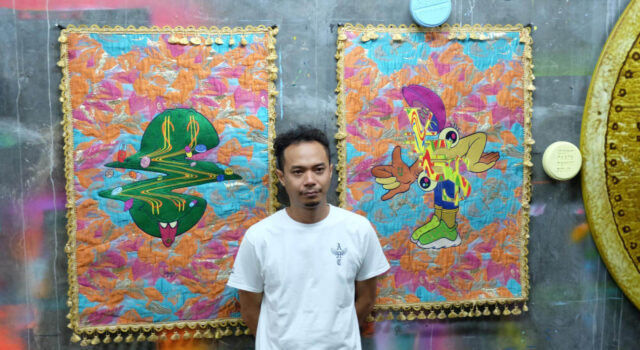Uji ‘Hahan’ Handoko, born in 1983 in Kebumen, Indonesia, is an artist whose work dances between the realms of ‘high art’ and ‘low art,’ critiquing and engaging with the expanding global art market. A graduate of the Faculty of Fine Art at the Indonesia Institute of the Arts in Yogyakarta, Hahan draws from a diverse array of influences including Javanese mythology, underground comics, youth culture, film, and street art, crafting a bold and vibrant visual language. His creations—spanning painting, sculpture, drawing, and printmaking—are a reflection of the intricate dynamics between local traditions and global modernity, urbanization and agrarianism. His work is characterized by bold, dynamic visuals teeming with color and movement, often infused with a playful yet satirical humor. Hahan blurs the boundaries between realism and decoration, creating layered, topsy-turvy compositions that critique societal norms, explore the dualities of success and rejection.
Hahan’s career is marked by significant milestones, including his participation in the National Art Studio residency program in Seoul in 2008, being a finalist for the Sovereign Asian Art Prize, and his exhibitions in prestigious venues such as the Queensland Art Gallery/GOMA and the National Gallery of Australia. His works have been featured in major triennials and exhibitions, including the NGV Triennial in Melbourne, the Asia Pacific Triennial in Brisbane, and Contemporary Worlds: Indonesia in Canberra. Notably, his series Speculative Entertainment No.1 has been presented at ART|JOG|9 in Indonesia and Darren Knight Gallery in Australia. Hahan’s art has been acquired by several prominent collections, including QAGOMA, the National Gallery of Victoria, and the National Gallery of Australia.
Beyond his individual practice, Hahan is a co-founder of the Ace House Collective, a Yogyakarta-based initiative that reflects Indonesian contemporary society through multidisciplinary projects. Grounded in satire and metaphor, his creations question the value systems of the art world while celebrating its absurdities. This approach, paired with his distinct visual language, makes his works both provocative and engaging, offering a critical yet accessible exploration of the intersections of culture, commerce, and creativity.


